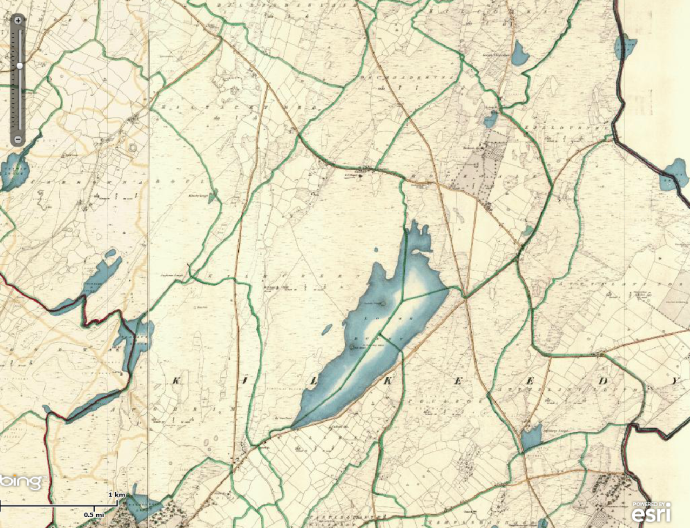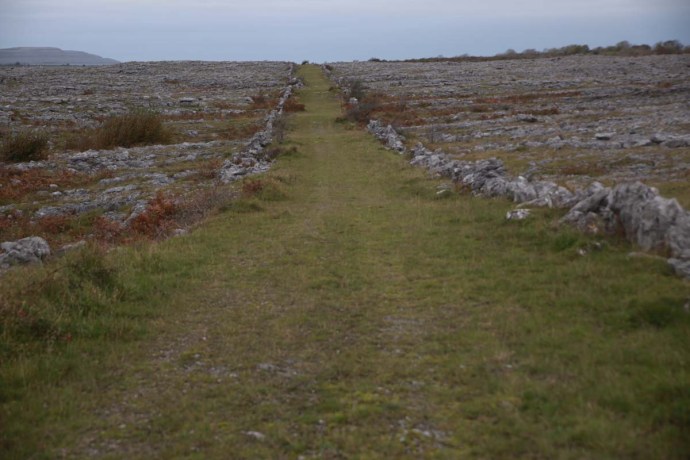This is first for me. For the last five years I have written blogs about my travels, but I have never written a travel blog. What I mean is that I have talked about places I’ve visited and experienced but have never written a travel diary as such. As I prepare to leave Ireland, I am madly trying to see places that I have neglected or counties that I have not explored. Wexford is the only county I have never visited. Time to fix that.
Before planning any road trip, I am keen to ensure the best possible light for my photography, so I am an avid consumer of weather apps and unless there are other constraints (such as a music festival) I am lucky enought to be able to pick my time. The hourly forecasts have become remarkably reliable as a predictor of sunshine, so on this particular Saturday, late in August it looked good for Sunday and Monday. Next morning, I headed off with the plan of an overnighter to Hook Head.
A quik aside. Travelling Ireland is in my mind unique. It is compact and chock full of rich and varied experiences that cover millenia and everything is pretty accessible. For me though, it’s not just about ticking monuments and sights off a list, it’s about the people you meet on the way, the side roads you take, the discoveries you make and colliding with the unexpected. I wanted to post this to show those contemplating a visit that you can do so much better than just consulting the Lonely Planet guide book or leaving it in the hands of your tour operator. And you can do so much more in limited time than anywhere else in the world. If you can though you have to be flexible. My planned two day trip to Hook Head ended up being a four day journey that took me through Tipperary, Wexford, Carlow and Wicklow. In the process I saw pretty much everything that Ireland can offer.
I’m not expecting the average visitor would want to cram as much as this into a visit. Perhaps you want to linger longer at one place. I find each stop speaks to me about how long I have to stay. You just have to listen. Some I was there only 15 minutes, others for 4 hours. In Wicklow on the last afternoon, I walked for 12 km, unable to call it quits.
Most of the places on this visit I have never been to before. You see, even in an Ireland where I have been relentlessly touring for five years you can still do that. There are constants but nothing is the same. You never tire of the stunning scenery and the prehistoric or historic legacy that screams at you of conquerors, wars, pestilence, struggle and achievement. Sure you can go to high profile, developed sites, where you can get a packaged and potted version of Ireland’s history, but for myself I like the Ireland that is hdden or the Ireland I discover by chatting to people on the way,
So, enough talk, do up your seatbelt and lets go.
Sunday morning’s start was later than I hoped, due to a session in Miltown Malbay the previous night. My destination for the night was Hook Head, about four hours drive. Plenty of time but nothing was set in stone. That’s the way I like to travel these days. I never know where I will end up and around five or six in the evening, I look for an Airbnb or B&B that suits or I just sleep in the car. I find that travelling to a BB puts an artificial constraint to the day and makes it difficult to be where you want to be for the evening light, or for an early start and the predawn light that the photographer in me craves.
I’ve left Clare behind as I travel through Limerick when just near the village of Pallasgreen close to the Tipperary border, I noticed a brown sign Very useful these brown signs. Bob’s Fifth Law of Travel –
Brown sign + Google = discovery.
Kilduff Castle it said. An evocative ruin of a 1550 Tower House, it was the home of the Hurley family until 1660s, when forced out by Cromwell, Destroyed in 1688 during the Jacobite war it has been left in ruins ever since. Access is restricted due to its perilous state. Something tells me there will be a lot less of it next time I visit.

Kilduff Castle

Kilduff Castle. Beyond repair?
Then it was on to Cahir Castle, Tipperary. There has been a fort at this location since the 3rd century but the castle that stands today was built in the 12th century by Conor O’Brien on a limestone rock jutting out of the river. Almost growing out of that rock it has been the site of countless attacks and sieges for centuries.

Cahir Castle.
The powerful Anglo-Norman family, the Butlers, came into the possession of the castle in 1375 . It was thought to be impregnable but, it was subsequently captured three times in its history: twice without a shot being fired. It fell to Devereux, Earl of Essex, in 1599 after it had been battered for three days with artillery; it surrendered without a fight to Inchiquin in 1647 and again to Cromwell in 1650. That man again!
Through all this though the Butlers managed to retain control until 1961, the last Lord Cahir died, and the castle reverted to the State.
It has looked the way it looks now since 1599 and is remarkably well preserved retaining its impressive keep tower, its original portcullis gate and winch mechanism and much of its defensive structure such as machiolations and canon. I even spotted a garderobe chute (tipping its contents straight into the river).
The forecast of sunshine for the afternoon was spot on and the River Suir was sparkling. The ducks and geese were having as much fun as the visiting Dutch or Greeks. To my mind, as with many of the ‘touristy’ reconstructed or restored castles it is a bit sterile and looks for all the world like a film set, which, not surprisingly, it has been for such films as Excalibur, Barry Lyndon and Tristan and Iseult. And recently it was the location for a new film, ’The Green Knight’, a fantasy re-telling of the story of Sir Gawain who embarks upon a quest to confront the titular Green Knight. There is no denying the stunning views from every vantage point though.

Caher Castle and the geese and ducks on the River SuirEnter a caption

The Banquet Room, Cahir Castle

View over the town of Cahir from the CastleEnter a caption
A short distance away, but in a parallel world, is the chocolate-box pretty of the Swiss House. Not Swiss but given that name by the locals due to its idiosyncratic architectural style known as ‘cottage orné’ which resembled in their mind a Swiss chalet. It was built in 1810 by the same Butlers, owners of the castle, as a rustic getaway.

The Swiss Cottage at Cahir Castle
The style was meant to reflect the disorder in nature and blend in, so the roof isn’t level, windows are of different sizes and external oak timbers are meant to resemble roots. A verandah surrounds it and makes it look bigger than it is. The patterns in the trellis work change constantly as you move around and the house never looks the same from any angle. The iron fence of intertwining branches dates from 1850. A Yew tree adjacent to the house is believed to be 1,000 years old making it one of the oldest in Ireland.. The cottage is now owned by the State and managed by OPW. No time for a tour inside, but nevertheless a charming and very non-Irish looking diversion.
It was time to head on through Tipperary towards my destination of Wexford. But one surprising deviation first. My road took me through Carrick-on-Suir. Some context here before I go on. This is one of the most passionate of the hurling places in Ireland. The county is renowned for its excellence in this most Irish of sports. The weekend before, Tipp had won the All Ireland for the 27th time. The celebrations were still going on on the street. I stopped at a place, which I later learned was named Sean Tracy Park. [The name is in honour of Tipperary man Seán Treacy, one of the leaders of the IRA who was killed in October 1920, in Dublin, in a shootout. His name is revered in West Tipperary and associated with hurling.]
It was festooned with bunting and flags and numerous placards of hurlers in a coordinated display of blue and yellow. The bright sunshine had brought people onto the street, everywhere talking hurling and reliving the glory. As I clicked away I heard a voice. “Are we gonna be on News of the World?”. I had to disappoint him that it was only the News of Australia. He told me that following their Senior win they had just won the Under 20s and that they were going for the Trifecta, with the Ladies playing the next weekend.
I learnt a lot that afternoon. Of the passion for a uniquely Irish game and of a corner of the world where there was a real community spirit. In a world where many of us live our lives in reclusive isolation in front of a TV screen or on a hand held screen this was a refreshing flashback to a community existence where fences between houses don’t exist. I recalled vague memories of growing up in Sydney in the fifties, where life was lived outside, the street was your front yard and there were endless games of cricket.
I knew Tipperary was one of the Big Three in hurling. In fact they won the very first All Ireland in 1887 and have won another 26 since including this year’s. Preeminence in hurling is seen as a simple fact of life in Tipperary. Michael Cusack, the founder of the GAA, once said “Tipperary was the benchmark by which every other county would be judged.” Looking at the street display I asked my friend from earlier, “Is all of Tipp like this”. “Ah no he said. “Carrick on Suir is special.” As if to confirm this, I later found a reference to an article from the Tipperary Advocate of 1887 decrying the violence in the game. It reported “disgraceful scenes” in Clonmel when a game against Carrick developed into a brawl and ending in a bout of stone-throwing. The Gardai were called but it was a sense of continuing bitterness that Carrick men were blamed with no arrests of anyone from Clonmel. It was a much more peaceful scene on this sunny Sunday 132 years later. I wished him luck for the Trifecta and resumed my journey.
But I couldn’t leave Carrick on Suir without visiting Ormond Castle. Another of Butler’s many properties. This one was a fortified Tudor Manor House (Ireland’s only such building) dating from 1560s. What I found really interesting though is how this elegant building integrated and incorporated an earlier fortified castle dating from the 14th century and and not one but two Tower Houses of different ages. Here I wished I’d had more time to look inside at the splendour of Thomas Butler’s house, built, it is said. to impress Queen Elizabeth I (for whom he had a bit of a thing). Sadly she never came to visit.

Front view of Ormond Manor House

Rear viewo Ormond House taken from the 14th Century castle and showing the two tower houses.

The 16th century Manor House abuts against one ot the earlier Tower Houses.
Leavng Carrick on Suir, to get to Wexford you must travel along the River Suir in Kilkenny until it meets the Barrow (the second longest river in Ireland) and then follow that north to its first crossing at New Ross. On the way at Granagh, you are confronted by an impressive bridge over the Suir . Just before the bridge is yet another castle, Castle Granagh, also known by the perhaps less threatening name, Granny Castle. Another strategically placed defensive site on a bend of the Suir just west of Waterford, there was a Celtic fort built at this spot as long ago as the 1st century. This one is a typical Norman castle with a courtyard and towers in each corner. The large keep tower may have been added in the 15th century. Originally built by the Power family, when they fell out of favour it was granted to, yes, the Butlers, in 1375. Until, yet again, in 1650 taken by Cromwell and destroyed. History definitely keeps repeating itself around here.

Castle Granagh
Three intrepid (or should I say foolish) lads managed to get inside one of the corner towers. A perilous exercise and not for the faint hearted. I am happy to report that they got out ok.
I grabbed one more look at the view that juxtaposed a bold architectural statement of the 21st century bridge with a castle that combined elements of the 13th, 14th, 15th and 17th centuries, before I was back on the road to Wexford.

Granagh Castle and the bridge over the River Suir
It was 4.30 pm when I got to the historic riverside port town of New Ross, with its the three-masted tall ship, The Dunboy Famine Ship, dominating its skyline. I had to pay a visit, though I hadn’t intended to stop. There I discovered yet another Interpretive Centre, Restaurant, Cafe and Museum complex, and another request for €9. The Dunboy is actually a replica of a ship that was genuinely used in the 1840s and it is open to the public. Resigned to parting with my €9, I thought I would have a look.

The Dunboy Famine Ship and the River Barrow at New Ross
“Yes Sir, we do have a tour starting at 4.45”. I looked up at the prominently displayed clock above the desk. It says 4:50.
“So I have missed the tour?” keeping in mind though that I might be saved by the well-known Irish skill at timekeeping.
“Yes Sir. It didn’t run. There were no takers”. For the first time I came across a tour that ran on time but didn’t, if you get my drift.
“So I can’t get on and have a look?” I said disappointedly
“Oh yes. if you want to do it on your own you can, you just can’t go on a tour,”
I smiled. I’d never actually said I wanted to go on a tour.
I still had to fork out my €9 but the upshot was that I was given a laminated script of the tour (it’s even called a ‘script’) and I headed on board. I had the boat to myself. I had limited expectations, but I have to say I found it a thought provoking and surprisingly moving experience. The boat is a replica of the vessels that used to carry desperate folk escaping Ireland in the 1840s. These boats were not designed for transporting people. They were opportunistically used by traders engaged in shipping timber and other goods from Canada and the US to Ireland. The return journey would take passengers instead of going back empty.
It is difficult for us to conceive of the situation at that time. Stop for a minute and think on this. Ireland, with a population of 9 million was desperate. The US had a population (including slaves) of 18 million. As a result of the famine, 1 million people died and 2 million left in the space of 3 to 4 years. On some ships up to half the passengers died during the voyage. As an afterthought, Ireland now has 4 million and the US, 320 million.
The Dunboy carried as many as 300 on each trip on makeshift temporary bunks. Minimal rations were provided. You were expected to bring your own food. Imagine that; leaving famine-ravaged Ireland and you had to bring enough food for you and your family for 6 to 10 weeks. You had one hour a day to cook for yourselves in an open fire on deck. With twenty others at a time. That was the only light you saw. The rest of the time you were in your cabin in your bunk. Speaking of the bunks. They were 6’ by 6’ double bunks. Each person had an allocation of 6’ by 18”, which meant there was room for four adults. Children had half that. You were expected to share with complete strangers. There were no toilets either. Just a bucket and you shared that. Cholera and typhoid were rife and there was no washing possible; most didn’t have a change of clothes. All this was preferable to staying at home. At least there was hope.

Sleeping bunks in Steerage class

The bunks are 6′ by 6′ and accommodate four adults. This is where passengers lived for 23 hours each day.

The crew had individual bunks in the foc’sle

The Captain’s cabin at the back of the ship.

On deck cooking facility and toilet bucket
This crystallised the sense I got when I walked part of the Famine Road in the Burren or visited a famine graveyard on Achill Island. Putting flesh on the bones to use a very inappropriate metaphor. Being alone on the ship gave me time to absorb and ponder on those brave souls who made that perilous journey to a country that welcomed them, if they survived the trip, with the promise of a new life. A different America today that turns victims of injustice away.
The captain, who, by all accounts was humane and caring, fared a little better in the Saloon at the back of the ship. There were four cabins here, accommodating the senior crew and two passenger cabins and the crew had individual bunks in the foc’sle.
I loved the safety notice thoughtfully provided in the script, which I returned with thanks to the desk. “For safety reasons please don’t fall in the river!” it said.
“Where are you from?” said the chatty man at the desk as I returned the script
“Australia”.
“How long are you here?”
“I’m heading back in a couple of weeks”, I said, skipping the bit about having been here five years. “Thankfully I’m travelling by plane and not ship!” I quipped. I don’t think he got it.
A stander-by (if that’s a word) engaged me in conversation, recognising my accent. He introduced himself; John from Melbourne, but currently living in London, had arrived in Ireland three days earlier with no return plans; to soak up Ireland, to write and just see what happens. That sounded very familiar, so we ended up having a coffee in a local café. He too was a musician and was staying in the house of another Australian musician friend, a member of a well-known Aussie rock band. There you go. I’ve always said that music is the thread that binds Ireland and binds us to Ireland.
He was interested in my story and we chatted for over an hour, before I had to take my leave. An invitation to a meal and an offer of accommodation followed, so we made arrangements to meet up the next day at his cottage in Carlow. These serendipitous meetings happen all the time in Ireland; in this case a snippet of an overheard conversation changed my travel plans.
It had been a perfect blue afternoon and I was looking forward to a spectacular sunset, but was starting to worry that I would be too late for it. Still I had to visit the ruined Dunbrody Abbey on the way. My hopes plummeted [insert scream here] when I saw that it was another visitor centre, this time with a Café, a Maze and a Pitch-and-Put centre and that access to the abbey included all these fringe benefits. The ruin of Dunbrody Castle sits adjacent to the facility. This castle built just prior to the 1640 rebellion was never actually finished and is now used as a craft shop.

Dunbrody Castle. Now a craft shop.
But all that was closed and with it access to the Abbey which was couple of hundred metres across the road. Thankfully you could walk around it though and that was what me and my camera did.
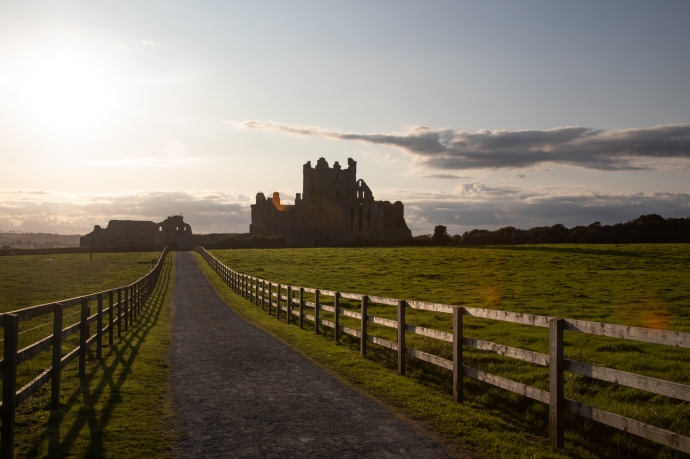
Dunbrody Abbey
It is a Cistercian Abbey dating from 1170, which prospered until the suppression of the monasteries in 1536. The ruin was left to the State in 1911. I would have liked to have gone inside, apparently it has one of the longest naves in the country. The monks here in the 14th century were pretty feisty, and it appears were often in dispute with their fellow Cistercians at nearby but much grander Tintern Abbey. I will be seeing that tomorow. But even from the outside I was having fun exploring the photographic possibilities that happen when evining light and a ruined abbey combine. Here are a few of the photos I took that I post without comment.
Just a couple of miles further south is the seaside village of Duncrannon. Protected since the 5th century by a Fort of some description, and even before that by a Promontory Fort that sits on the headland above the Quay. The only way to see it is with a tour and it was way too late for that so I had to be satisfied with viewing it from the wharf. And Duncrannon Fort is what is known as a Star Fort, built in that shape to maximise the coverage and angles for canons. Built in 1587 by Queen Elizabeth I to protect against the Spanish Armada, it saw much more local action during the Irish Confederate Wars of 1645 and then withstood an attack from Oliver Cromwell in 1649. A lighthouse was built there in 1774. During the 1798 Rebellion the United Irishmen failed to capture it and it became a safe house for fleeing loyalists and a prison and site of execution for rebels. The song the Croppy Boy tells one such story. Staying in the control of the British Army it was burnt down in 1922. Now it is a museum. It looked truly formidable sitting high on the cliffs above the ocean.

Duncrannon Fort from the water
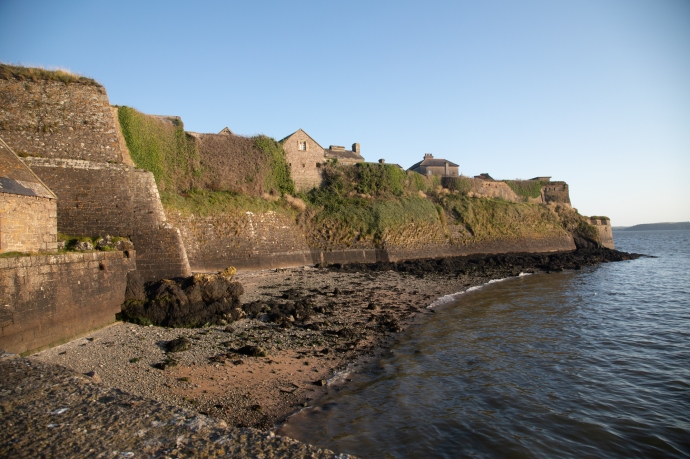
Duncrannon Fort another view

Entrance to Duncrannon Fort
It was now after 7pm with less than an hour to sunrise and finally within reach of my goal. But I couldn’t resist one more stop. The village of Templetown, which may have been a village once but is now just a roadside bar and restaurant (but a popular one it would seem). Across the road is a the Templetown Church ruin. This was the base for the Knights Templars, a military religious order founded in Jerusalem to protect the Holy Land, who set up here in 1172, giving the name to the locality. The Templars however disbanded in 1307 and their lands were given to their great rivals, another military order, the Knights Hospitallers. They built this church and its adjacent fortified tower. It is in wonderful condition, just missing its roof, and is surrounded by a small graveyard. It looked spectacular and glowed golden against a vivid blue evening sky. I’ll have reason to talk about these fellas again.
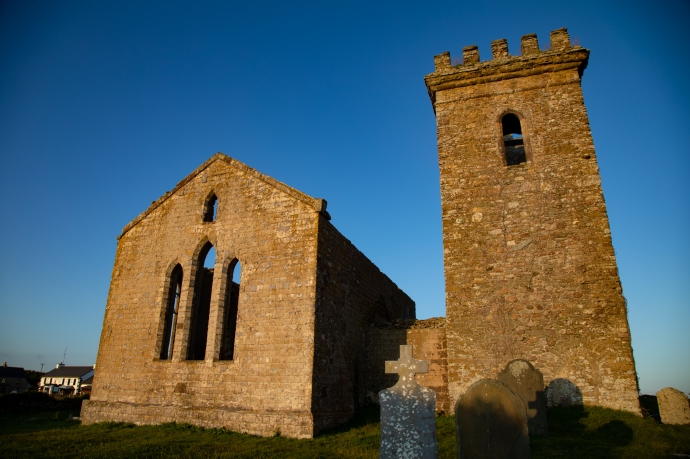
Templetown Church

Templetown Church and graveyard

Templetown Church

Graveyard at Templetown Church
Paradoxically, with light running out, the next stop was definitely Hook Head Lighthouse. I could see it in the distance and at the first opportunity I pulled off the road to photograph it. The lighthouse is not the prettiest in Ireland, with its chunky disproportionate base, but it is iconic and it is the oldest and is spectacularly located (I guess most of them are).

A distant view of Hook Head Lighthouse
It was built by William Marshall, who had a few strings in his bow, so to speak. He was Strongbow’s successor (get it?) as Lord of Leinster, and had built a port at New Ross, which was 30 km up the river. Told you I’d come back to the Templars; well Marshall was also a Knights Templar (he was known as the Greatest Knight). The light was erected at the beginning of the 13th century and it was the monks at Templetown who became the first keepers. They looked after the lighthouse tower until 1641 when dedicated lighthouse keepers took over until it was automated in 1996. It is the oldest operating lighthouse in the world.

Hook Lighthouse and the old Keepers’ cottages, now a visitor centre.

A view from the other side with the sun setting behind Hook Head lighthouse

The lads are off for a fish.
That’s something to ponder on – a guiding light for 800 years. I can’t leave though without mentioning the expression ‘by hook or by crook’. One theory (and it is only one of a number) is that the expression came from Oliver Cromwell who had to make the decision whether they would sail up the Barrow on the Wexford side (by Hook) or by Crooke (a village on the Waterford side). Only problem is there is a reference to the expression in a Middle English tract dated 1387, nearly 300 years before Cromwell. Wherever the expression came from I got there by hook or by crook and I became immediately hooked on the place.
As darkness descended I looked at the collection of campervans parked on the clifftop at the base of the lighthouse, with just a hint of envy. I searched for a spot to park up, claiming my spot right on the cliff edge next to an old limekiln and looking across to Passage East in Waterford on the other side of the Barrow. I wouldn’t say I had the best night’s sleep but was well satisfied with an exhausting but rewarding day of travel.

The view from my five star accommodation at Hook Head.
And as a bonus from my vantage point in the back of the car, I watched the rising of the crescent moon and photographed the Milky Way, managing to catch a couple of shooting stars. Where else would you want to be.

The Rising of the Moon

The Milky Way. There are two shooting stars if you look closely
Well that’s Day 1 of this four day journey. It’s long I know and thank you for sticking with me to the end. Stay tuned for Day 2 which will take me north through Waterford towards Carlow.























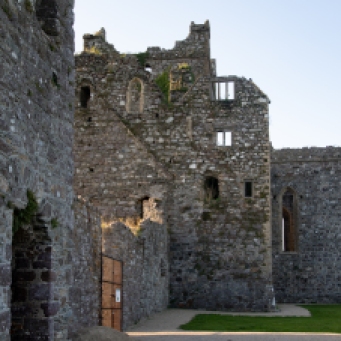





















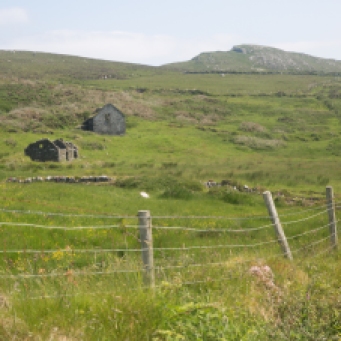
































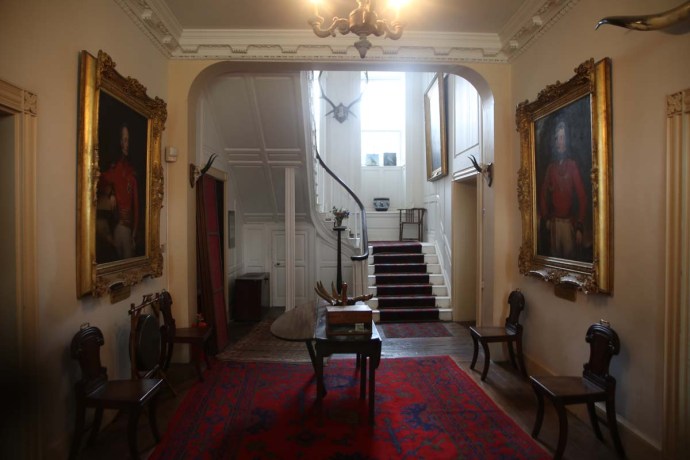










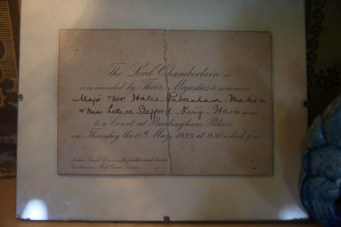























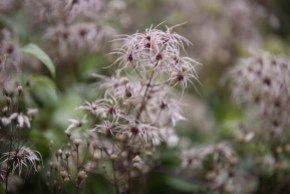














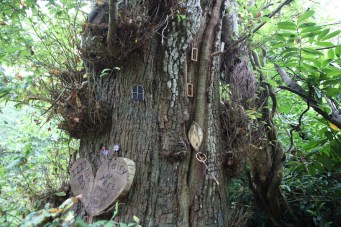
















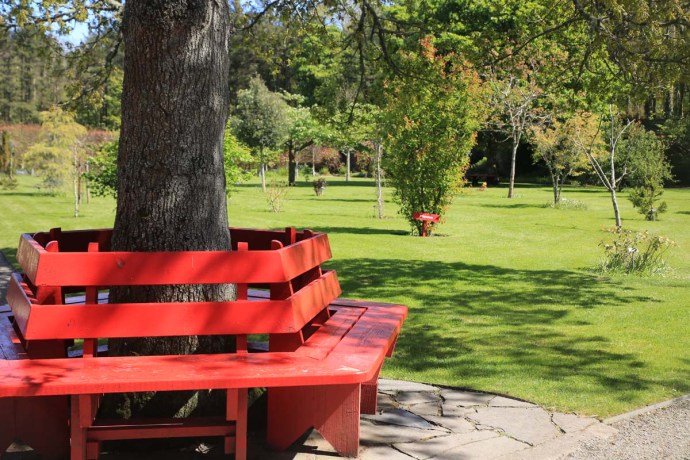





















 The mob was resolute in its intent and ruthless in its implementation. Here is a description of the demolition of the house of Michael Cleary, near Moneypoint.
The mob was resolute in its intent and ruthless in its implementation. Here is a description of the demolition of the house of Michael Cleary, near Moneypoint.



